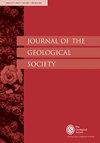Age, duration, and spatial distribution of ocean shields and rejuvenated volcanism: Fuerteventura and Lanzarote, Eastern Canaries
IF 2.6
3区 地球科学
Q2 GEOSCIENCES, MULTIDISCIPLINARY
引用次数: 1
Abstract
Fuerteventura and Lanzarote (Eastern Canary Islands), form the oldest emerged part of the archipelago. Geologically, they can be considered a single edifice, constituting a continuous volcanic ridge extending 250 km from SW to NE. This work completes the dating and the determination of the magnetic stratigraphy of the shields and the rejuvenated volcanism of Fuerteventura and Lanzarote, refining the volcanic stratigraphy and cartography. The new unspiked K-Ar ages and magnetostratigraphy of Fuerteventura and Lanzarote indicate that these islands developed patterns similar to those of the Central and Western Canary Islands, building adjacent and successively superimposed basaltic shield volcanoes during the Miocene, between 20.19 ± 0.30 and 6.30 ± 0.11 Ma. The overlay of post-Miocene rejuvenated volcanism hinders the extent and interrelationship of the shields. These materials constitute only a small fraction by volume but cover a large part of the islands. Despite this, it is confirmed that the disposition of the shields is opposite to the insular progression induced by the hot spot, suggesting the presence of some SW-NE propagation volcanic front or fracture to explain its direction of development. Supplementary material: https://doi.org/10.6084/m9.figshare.c.6641464海盾和新生火山活动的年龄、持续时间和空间分布:富特文图拉和兰萨罗特,东加那利群岛
Fuerteventura和Lanzarote(东加那利群岛)构成了该群岛最古老的部分。从地质学上讲,它们可以被视为一个单一的建筑,构成了一个从西南到东北延伸250公里的连续火山脊。这项工作完成了地盾磁性地层学的测年和确定,以及富特文图拉和兰萨罗特火山活动的恢复,完善了火山地层学和制图。Fuerteventura和Lanzarote的新的未标定K-Ar年龄和磁地层学表明,这些岛屿形成了与中加那利群岛和西加那利岛相似的模式,在中新世期间,在20.19±0.30和6.30±0.11 Ma之间,建造了相邻的并连续叠加的玄武岩盾状火山。后中新世复活火山活动的叠加阻碍了地盾的范围和相互关系。这些材料只占体积的一小部分,但覆盖了岛屿的大部分。尽管如此,已经证实,地盾的布置与热点引起的岛屿发展相反,这表明存在一些SW-NE传播的火山前缘或断裂,以解释其发展方向。补充材料:https://doi.org/10.6084/m9.figshare.c.6641464
本文章由计算机程序翻译,如有差异,请以英文原文为准。
求助全文
约1分钟内获得全文
求助全文
来源期刊

Journal of the Geological Society
地学-地球科学综合
CiteScore
6.00
自引率
3.70%
发文量
68
审稿时长
6-12 weeks
期刊介绍:
Journal of the Geological Society (JGS) is owned and published by the Geological Society of London.
JGS publishes topical, high-quality recent research across the full range of Earth Sciences. Papers are interdisciplinary in nature and emphasize the development of an understanding of fundamental geological processes. Broad interest articles that refer to regional studies, but which extend beyond their geographical context are also welcomed.
Each year JGS presents the ‘JGS Early Career Award'' for papers published in the journal, which rewards the writing of well-written, exciting papers from early career geologists.
The journal publishes research and invited review articles, discussion papers and thematic sets.
 求助内容:
求助内容: 应助结果提醒方式:
应助结果提醒方式:


